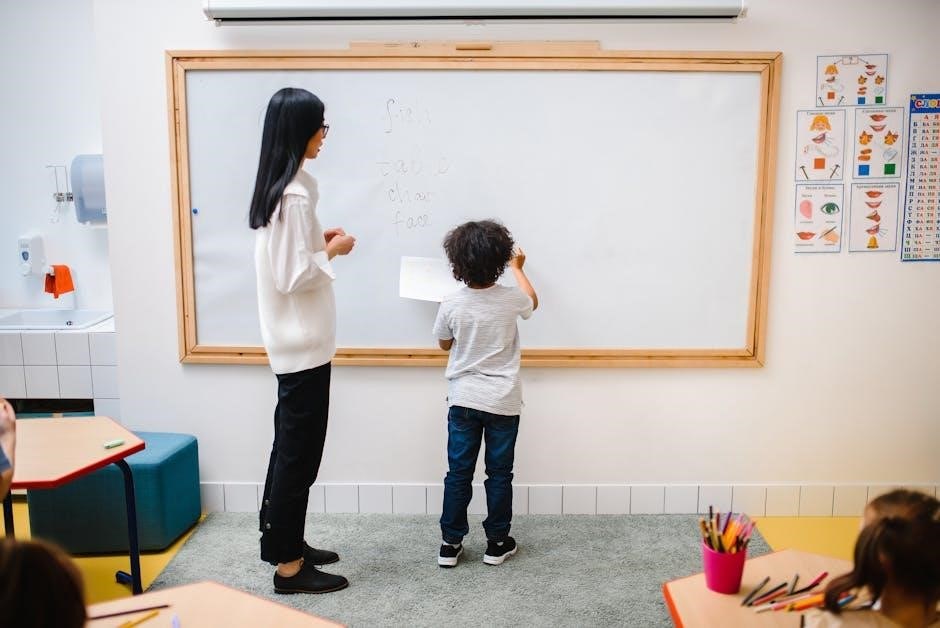The framework for effective instruction develops foundational level skills, with three key levels of adolescent literacy instruction, including foundational, transitional, and advanced levels of literacy skills development for students.
Definition and Importance of Literacy Instruction
Literacy instruction is a crucial aspect of education, as it enables students to acquire the skills necessary to read, write, and communicate effectively. The definition of literacy instruction encompasses a range of skills, including reading, writing, speaking, and listening. Effective literacy instruction is essential for students to succeed in all areas of their academic and personal lives. It provides students with the foundation to access and understand various subjects, including mathematics, science, and social studies. Furthermore, literacy instruction plays a vital role in promoting critical thinking, problem-solving, and analytical skills. By acquiring literacy skills, students can navigate complex texts, evaluate information, and express their thoughts and ideas clearly. The importance of literacy instruction cannot be overstated, as it has a profound impact on students’ academic achievement, career prospects, and overall quality of life. Literacy instruction is the key to unlocking students’ full potential and empowering them to become active participants in their communities. Effective literacy instruction is critical for students to become informed, engaged, and productive members of society.
Overview of the Three Levels of Adolescent Literacy Instruction

The three levels of adolescent literacy instruction provide a framework for understanding the progression of literacy skills development in students. This framework is based on the idea that students progress through distinct levels of literacy instruction as they mature and develop their skills. The three levels are designed to be sequential, with each level building on the previous one to provide a comprehensive and cohesive approach to literacy instruction. By understanding the three levels, educators can tailor their instruction to meet the unique needs of their students and provide targeted support to help them achieve their full potential. The levels are also flexible, allowing educators to adapt their instruction to meet the diverse needs of their students. Overall, the three levels of adolescent literacy instruction provide a valuable framework for promoting student learning and achievement. This framework can be used to inform instruction and support student success. Educators can use this framework to develop effective instructional strategies.

Level 1: Foundational Literacy Instruction
Foundational literacy instruction focuses on basic reading skills for struggling students, providing essential support and guidance to develop literacy skills and build confidence in reading and writing abilities slowly.
Characteristics of Foundational Literacy Instruction
Foundational literacy instruction is designed for students who require intensive support to develop basic reading skills. The characteristics of this level of instruction include a focus on phonemic awareness, phonics, and fluency; Students at this level typically require explicit and systematic instruction to develop a strong foundation in literacy skills. The instructional strategies used at this level are often highly structured and provide ample opportunities for practice and review. Additionally, foundational literacy instruction often involves the use of multisensory approaches to help students connect the sounds of language to the written word. This level of instruction is critical for students who are struggling to develop basic literacy skills, as it provides the necessary support and scaffolding to help them build a strong foundation for future reading and writing development. The ultimate goal of foundational literacy instruction is to help students develop the skills and confidence they need to succeed in more advanced literacy instruction.
Instructional Strategies for Foundational Literacy Instruction
Instructional strategies for foundational literacy instruction include explicit and systematic teaching of phonics, phonemic awareness, and fluency. Teachers use a variety of techniques such as modeling, guided practice, and independent practice to help students develop these skills. Multisensory approaches, such as using visual, auditory, and kinesthetic methods, are also effective in helping students connect the sounds of language to the written word. Additionally, teachers may use technology, such as text-to-speech software, to provide students with additional support and practice. The use of data-driven instruction, where teachers use assessment data to inform their instruction, is also critical in ensuring that students receive targeted support. By using these instructional strategies, teachers can provide students with the support and scaffolding they need to develop a strong foundation in literacy skills. Effective instructional strategies can help students build confidence and develop the skills they need to succeed in more advanced literacy instruction. The key is to provide a structured and supportive learning environment that meets the needs of all students.

Level 2: Transitional Literacy Instruction
Transitional literacy instruction focuses on students making progress towards grade level reading proficiency with targeted support and scaffolding techniques to enhance literacy skills development for struggling readers slowly.
Characteristics of Transitional Literacy Instruction
Transitional literacy instruction is designed for students who are making progress towards grade level reading proficiency. This level of instruction focuses on providing targeted support and scaffolding techniques to enhance literacy skills development. The characteristics of transitional literacy instruction include a focus on building reading fluency, vocabulary development, and comprehension strategies. Students at this level require ongoing support and feedback to help them overcome reading challenges and develop a stronger foundation in literacy skills. The instructional strategies used at this level are designed to be highly supportive and responsive to the needs of the students, with a focus on helping them to become more independent readers. The goal of transitional literacy instruction is to help students transition from a period of intensive support to a point where they can read and comprehend complex texts with greater ease and accuracy.
Instructional Strategies for Transitional Literacy Instruction
Instructional strategies for transitional literacy instruction include the use of scaffolding techniques, such as text marking and annotation, to support students as they read and comprehend complex texts. Teachers may also use strategies like think-alouds and peer discussion to help students develop a deeper understanding of the material. Additionally, instructional strategies like close reading and literary analysis can help students build their critical thinking and analytical skills. The use of technology, such as online reading platforms and educational apps, can also provide students with additional support and practice opportunities. By providing targeted and supportive instruction, teachers can help students in the transitional phase build their confidence and competence as readers. Effective instructional strategies can also help to identify areas where students may need additional support or intervention, allowing teachers to provide more targeted and effective instruction. This can include small group instruction and one-on-one support.

Level 3: Advanced Literacy Instruction
Advanced literacy instruction focuses on complex texts and critical thinking skills development for proficient readers with higher level skills and knowledge application.
Characteristics of Advanced Literacy Instruction
Advanced literacy instruction is characterized by its focus on complex and nuanced texts, requiring students to demonstrate a high level of critical thinking and analytical skills. The instruction is tailored to meet the needs of proficient readers, who are able to comprehend and interpret a wide range of texts, including literary and informational works. The characteristics of advanced literacy instruction include the use of sophisticated vocabulary, complex sentence structures, and abstract concepts. Students are expected to engage in deep discussions, debates, and written reflections, demonstrating their ability to think critically and make informed decisions. The instruction also emphasizes the development of specialized knowledge and skills, such as literary analysis, research, and technical writing. Overall, the characteristics of advanced literacy instruction are designed to challenge and engage proficient readers, preparing them for success in their academic and professional pursuits. The instructional strategies used in this level are highly effective in promoting advanced literacy skills.
Instructional Strategies for Advanced Literacy Instruction
Instructional strategies for advanced literacy instruction include the use of Socratic seminars, literature circles, and writing workshops. These strategies promote critical thinking, analytical skills, and effective communication. Teachers use a variety of techniques, such as close reading, textual analysis, and evidence-based discussions, to engage students in deep learning. The instructional strategies also emphasize the development of research skills, including the ability to locate, evaluate, and synthesize complex sources. Additionally, teachers use technology to support advanced literacy instruction, such as online discussions, digital writing tools, and multimedia presentations. The goal of these instructional strategies is to provide students with a rigorous and supportive learning environment that challenges them to think critically and creatively. By using these strategies, teachers can help advanced learners develop the skills and knowledge they need to succeed in their academic and professional pursuits. Effective instructional strategies are essential for promoting advanced literacy skills.
